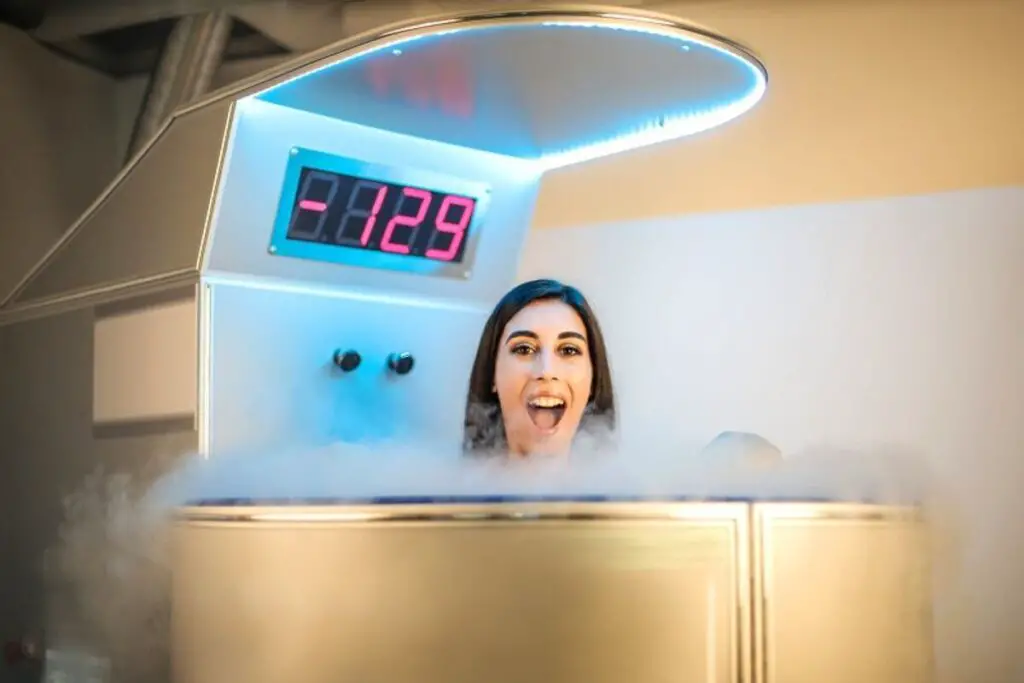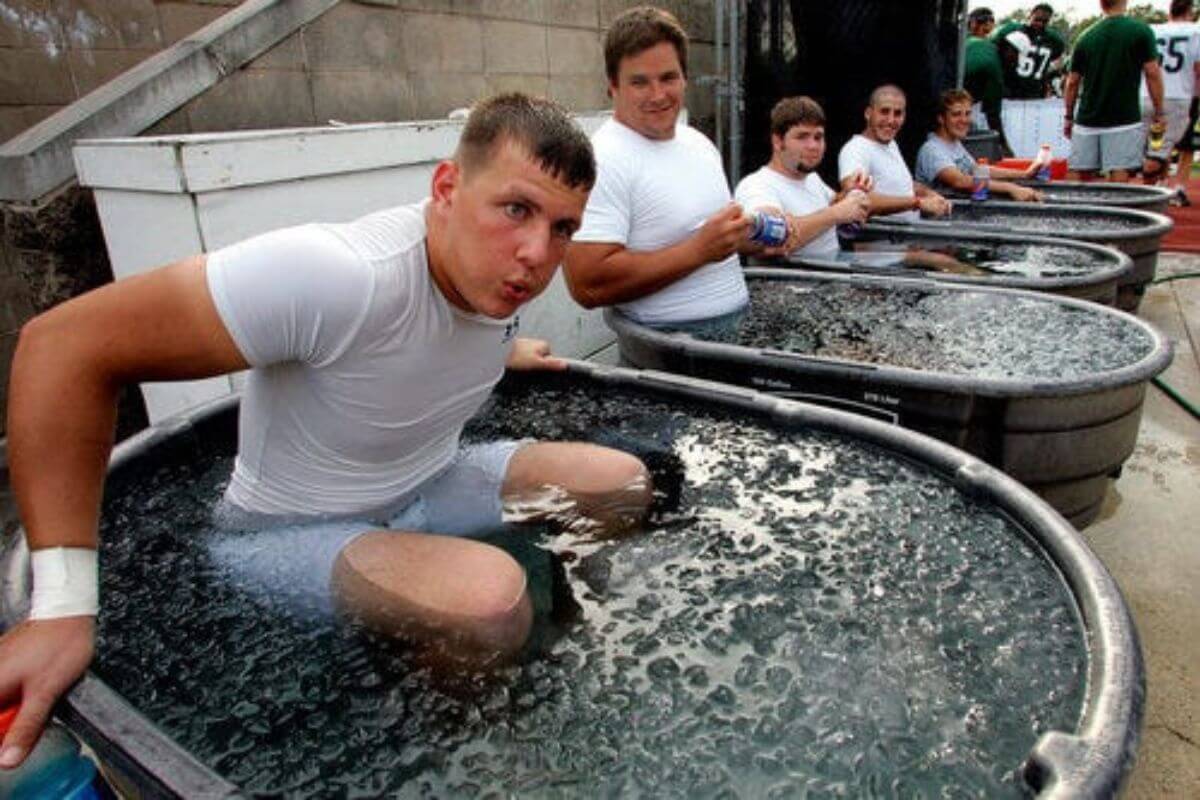In the pursuit of recovery and enhanced performance, athletes and individuals seeking therapeutic benefits have long turned to cold exposure methods. Two popular choices in this realm are cryotherapy and ice baths. Each method involves subjecting the body to extreme cold, but which one stands out as the superior option? In this in-depth analysis, we’ll dissect the nuances of cryotherapy and ice baths to determine which cold therapy method reigns supreme.
Understanding Cryotherapy
Cryotherapy, or “cold therapy,” involves exposing the body to extremely low temperatures, typically ranging from -200°F to -300°F (-129°C to -184°C). This brief but intense cold exposure is often administered in specialized cryo chambers, where individuals are enveloped in a cloud of nitrogen gas for a short duration, usually three minutes or less.

Advantages of Cryotherapy:
Quick and Efficient:
Cryotherapy sessions are brief, often lasting only a few minutes, making it a time-efficient option for those with busy schedules.
Localized Application:
Cryotherapy can be targeted to specific areas of the body, allowing for localized cold exposure and potential relief for specific injuries or soreness.
Potential for Faster Recovery:
Advocates of cryotherapy suggest that the rapid cold exposure may lead to faster muscle recovery, reduced inflammation, and improved overall well-being.
Breaking Down Ice Baths
On the other end of the spectrum, ice baths, also known as cold water immersion or cryotherapy, involve submerging the body, typically from the waist down, in icy water. The water temperature can vary but generally falls within the range of 50°F to 59°F (10°C to 15°C). Sessions typically last around 10 to 20 minutes.
Advantages of Ice Baths:
Accessible and Cost-Effective:
Ice baths can be easily implemented without the need for specialized equipment, making them a more accessible and cost-effective option.
Customizable Temperatures:
Users have the flexibility to adjust the water temperature based on personal preferences and tolerance levels.
Muscle Soreness Relief:
Ice baths are often praised for their ability to alleviate muscle soreness, reduce swelling, and potentially enhance recovery after intense physical activity.
Comparative Analysis: Cryotherapy vs. Ice Baths
**1. Temperature Differential:
- Cryotherapy: Involves extremely low temperatures, creating a rapid and intense cold exposure.
- Ice Baths: Offers a more gradual temperature decrease, allowing individuals to acclimate to the cold over the duration of the immersion.
**2. Duration of Exposure:
- Cryotherapy: Sessions are short, typically lasting three minutes or less.
- Ice Baths: Sessions are more prolonged, lasting around 10 to 20 minutes.
**3. Convenience:
- Cryotherapy: Quick sessions make it convenient for those with tight schedules.
- Ice Baths: Require more time commitment but can be done at home with minimal equipment.
**4. Localized Treatment:
- Cryotherapy: Allows for targeted, localized treatment.
- Ice Baths: Primarily submerge specific areas, often from the waist down.
**5. Cost:
- Cryotherapy: Typically involves a fee for each session, as specialized cryo chambers are used.
- Ice Baths: More cost-effective, especially if done at home with readily available materials.
Choosing the Right Cold Therapy: Personal Considerations
The choice between cryotherapy and ice baths ultimately depends on individual preferences, goals, and logistical considerations. Here are some factors to consider:
**1. Time Constraints:
- If time is of the essence, cryotherapy may be a more suitable option due to its shorter sessions.
**2. Budget:
- Consider your budget, as cryotherapy sessions often come with a cost, whereas ice baths can be more budget-friendly.
**3. Targeted vs. Whole-Body Treatment:
- Determine whether you need targeted treatment for specific areas (cryotherapy) or prefer a more comprehensive approach (ice baths).
**4. Temperature Sensitivity:
- Consider your tolerance for extreme cold. If the thought of submerging in icy water is daunting, cryotherapy might be a more comfortable choice.
**5. Accessibility:
- Evaluate the accessibility of cryotherapy facilities in your area versus the convenience of setting up an ice bath at home.
Conclusion: The Chilling Verdict
In the realm of cold therapies, the superiority of cryotherapy or ice baths is subjective and contingent on individual needs. Cryotherapy’s quick sessions and potential for targeted treatment appeal to those with busy schedules and specific concerns. On the other hand, ice baths offer a cost-effective, accessible option for individuals seeking a more prolonged, whole-body cooling experience.
The verdict? It’s a personal one. Experiment with both methods, consider your preferences, and listen to your body’s response. Whether you opt for the futuristic embrace of cryotherapy or the classic chill of an ice bath, the goal remains the same – to harness the benefits of cold therapy for improved recovery and well-being.
Fine-Tuning Your Cold Therapy Experience: Tips for Optimal Results
Now that we’ve dissected the nuances of cryotherapy and ice baths, let’s delve into tips to enhance the effectiveness and overall experience of these cold therapies.
Cryotherapy Enhancement Tips:
**1. Layering for Comfort:
- Wear minimal clothing during cryotherapy sessions to ensure optimal skin exposure. This allows for a more effective and comfortable experience.
**2. Preventing Frostbite:
- Protect extremities susceptible to frostbite, such as fingers and toes, by using gloves and socks. Cryotherapy’s extreme temperatures demand careful attention to vulnerable areas.
**3. Post-Cryo Hydration:
- Rehydrate after a cryotherapy session to counteract potential dehydration caused by the cold exposure. Water or electrolyte-rich beverages are ideal choices.
Ice Bath Enhancement Tips:
**1. Temperature Monitoring:
- Use a thermometer to monitor water temperature accurately. Aim for a range of 50°F to 59°F (10°C to 15°C) to achieve the desired therapeutic effects without excessive discomfort.
**2. Adding Epsom Salt:
- Enhance the muscle-soothing benefits by adding Epsom salt to your ice bath. The magnesium in Epsom salt may contribute to muscle relaxation and recovery.
**3. Active Movement in the Bath:
- Gently move and stretch your limbs while in the ice bath. This not only improves circulation but also aids in the dispersion of cold water around the body.
Choosing the Right Method for You:
**1. Personal Tolerance and Comfort:
- Listen to your body’s signals. If you find one method more comfortable or tolerable, it might be the better choice for your individual preferences.
**2. Experimentation Period:
- Allow for an experimentation period to determine which method aligns with your recovery and wellness goals. Consistency in either cryotherapy or ice baths is key to gauging their long-term benefits.
**3. Combination Approach:
- Some individuals find value in combining both cryotherapy and ice baths within their wellness routine. This allows for a varied approach to cold therapy and may cater to different aspects of recovery.
Post-Cold Therapy Practices:
**1. Gentle Warming Activities:
- Engage in gentle warming activities post-cold therapy, such as light stretching or a warm shower. This aids in the gradual return of normal body temperature.
**2. Observing Body Responses:
- Pay attention to how your body responds to each method. Factors like improved sleep, reduced muscle soreness, and increased energy levels can serve as indicators of efficacy.
Conclusion: Elevating Your Cold Therapy Journey
In the realm of cryotherapy vs. ice baths, the efficacy of each method is undoubtedly influenced by personal preferences and physiological responses. By implementing these enhancement tips and fine-tuning your approach based on individual needs, you can elevate your cold therapy experience.
Remember, the key to reaping the benefits of cryotherapy or ice baths lies in consistency and careful attention to your body’s signals. Whether you choose the futuristic chill of cryotherapy or the classic immersion of an ice bath, the goal remains the same – to optimize recovery, promote well-being, and embrace the revitalizing power of cold therapy.
Frequently Asked Questions (FAQs) About Cryotherapy and Ice Baths
Is cryotherapy suitable for everyone?
Answer: While cryotherapy is generally considered safe for many individuals, it may not be suitable for those with certain medical conditions, such as circulatory disorders or heart conditions. It’s crucial to consult with a healthcare professional before undergoing cryotherapy, especially for individuals with pre-existing health concerns.
How often can I undergo cryotherapy sessions?
Answer: The frequency of cryotherapy sessions depends on individual goals and tolerance. Some individuals opt for daily sessions, while others prefer a few times per week. It’s advisable to start with fewer sessions and gradually increase based on how your body responds.
Can I do ice baths at home, and how do I set one up?
Answer: Yes, ice baths can be done at home. Fill a bathtub with cold water and add ice to achieve the desired temperature. Use a thermometer to monitor the water temperature and ensure it falls within the recommended range of 50°F to 59°F (10°C to 15°C). Start with shorter durations and gradually increase as your body acclimates.
Are there any risks associated with ice baths?
Answer: Ice baths pose minimal risks when done correctly. However, prolonged exposure or using water that is too cold can lead to issues such as frostbite or hypothermia. It’s crucial to monitor water temperature, limit session durations, and be attentive to your body’s signals.
Can cryotherapy help with muscle recovery?
Answer: Cryotherapy is believed to aid in muscle recovery by reducing inflammation and promoting vasoconstriction, which may help alleviate muscle soreness. Many athletes and fitness enthusiasts incorporate cryotherapy into their recovery routines to potentially enhance muscle recovery.
How long should an ice bath session last?
Answer: Ice bath sessions typically last between 10 to 20 minutes. It’s essential to pay attention to your body during the session and exit the bath if you experience excessive discomfort or numbness.
Are there any age restrictions for cryotherapy or ice baths?
Answer: Both cryotherapy and ice baths are generally safe for adults. However, individuals with specific health concerns or conditions should consult with a healthcare professional before incorporating these cold therapies. It’s not recommended for children without supervision and guidance.
Can cryotherapy or ice baths help with weight loss?
Answer: While both cryotherapy and ice baths may temporarily increase calorie expenditure due to the body’s efforts to stay warm, they are not considered primary methods for weight loss. The main benefits lie in potential muscle recovery, reduced inflammation, and overall well-being.
How do I manage skin exposure during cryotherapy?
Answer: For cryotherapy sessions, individuals typically wear minimal clothing, such as shorts and a sports bra for females. It’s important to follow the facility’s guidelines on attire and protect sensitive areas like hands and feet to prevent frostbite.
Can cryotherapy or ice baths help with sleep quality?
Answer: Some individuals report improved sleep quality as a potential benefit of cryotherapy or ice baths. The reduction in muscle soreness and overall relaxation from the cold therapy may contribute to better sleep for some users.
Feel free to reach out if you have additional questions or require further clarification on cryotherapy, ice baths, or any related topics.



